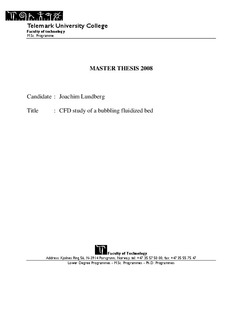| dc.description.abstract | The aim of this thesis is to investigate the momentum exchange between the phases in a bubbling fluidized bed. The momentum exchange can be described by a drag model. Several drag models with different assumptions are developed. The drag models investigated in this work is the Syamlal O’Brien model, the Gidaspow model, Hill Koch Ladd model, the RUC model and an iterative version of the Syamlal O’Brien called the Richardson Zaki model. The models have been derived and studied in detail. Simulations are performed with the commercial computational fluid dynamic (CFD) code Fluent 6.3. Different models for granular material in fluidized beds are available in Fluent 6.3. The models are mostly based on the kinetic theory granular flow (KTGF). The Syamlal & O’Brien drag model and the drag model developed by Gidaspow are included in Fluent 6.3. The Hill Koch Ladd model, the RUC model and the Richardson Zaki model are implemented in Fluent by the author. Implementation of models in Fluent 6.3 is performed by using the user defined functions (UDF). The UDFs are written in C-code. Preliminary simulations of a two dimensional fluidized bed with a central jet, are performed to investigate the effect of using turbulence models in the simulations. The laminar model gives results that agree well with experiments, and the turbulence models are not included in the further simulations. Simulations of bubble behaviour in two and three dimensional fluidized bed with uniform inlet gas distribution are performed. Simulations in three dimensions are limited to investigate the default settings in Fluent 6.3 for two different drag models. The simulations are compared to experimental data, and the results are presented in a paper accepted for HEFAT 2008. The main part of the simulations is done in two dimensions due to the limit of time and computational effort during this thesis. The two dimensional simulations with homogeneous air distribution in the bottom of the bed, is divided into five cases where different setups are investigated. The simulations are compared to experiments performed on a three dimensional fluidized bed, and the results agree well according to bubble frequency. It is found that a setup including multiple particle phases, free slip conditions at the walls of the bed, a second order discretization scheme for the momentum and the RUC drag model, gives the best agreement with the experimental results. This part of the thesis is presented in an abstract submitted to the SIMS 2008 conference. Further work has to be done to verify the suggested setup. | |
